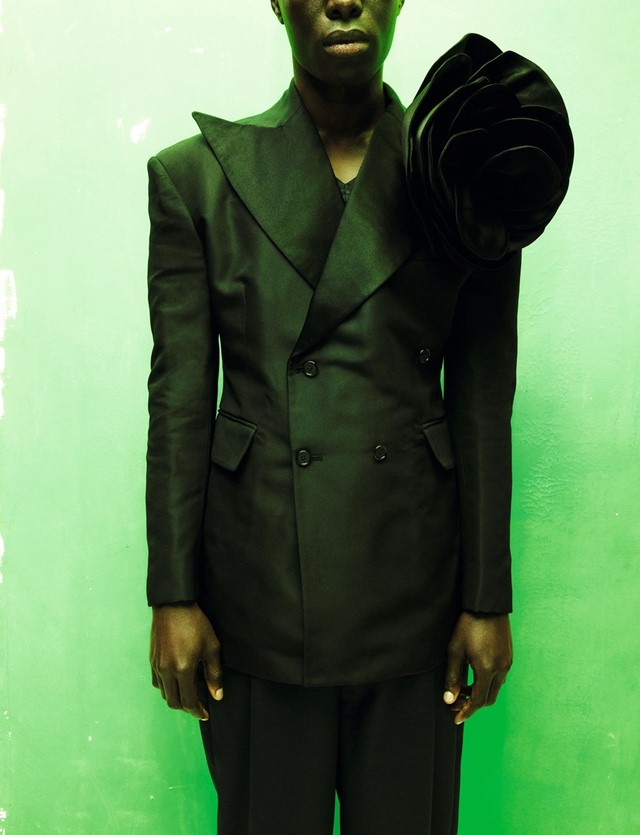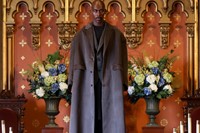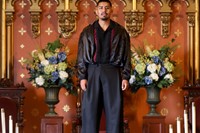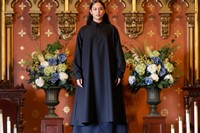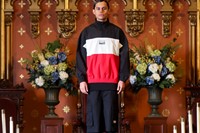Willy Chavarria’s Spring/Summer 2023 collection was about reclaiming space through expansive, voluminous fashion. Here, he talks to Jack Sunnucks about identity, activism, and why the industry needs his vision
This story is taken from the Spring/Summer 2023 issue of AnOther Magazine:
Willy Chavarria is home for the holidays, sitting on the front steps of his mother’s house in California. Bathed in winter sun, his back to the front door, the designer ponders his beginnings in fashion. Decades before the 2015 launch of his eponymous label, whose Spring/Summer 2023 show, Please Rise, has been much discussed in a rash of articles lauding its tailoring, casting and starry guestlist, Chavarria was working at a cycling-apparel company in his home state. “At that time I was very Polo Sport-ed out, like, head-to-toe Polo Sport – cap, shirt, shorts – like, the Chicano version of that vibe,” he says, with a laugh. “I was 100 per cent. Then Ralph Lauren launched the RL line and, of course, no one in New York knew how to design athletic clothing, so they contracted the company I was working for. I started working with Ralph Lauren, the company, long distance and then they recruited me to come to New York.” Chavarria has lived in the city ever since.
Chavarria’s work for his own brand over the past seven years has drawn upon a layered identity. He’s queer and Latinx and, as such, activism is embedded in his work, as expressed in the casting and locations of the shows he has put on – Spring/Summer 2022 took place at New York’s famous barbershop Astor Place Hairstylists, where chinos were taken to oversized extremes in pink, while for his Spring/Summer 2018 collection the designer burned incense before the show to mask the scent of poppers that pervaded its venue: the renowned leather bar The Eagle. And although the designer seems happy to serve as a cultural ambassador, he doesn’t always get to talk about clothes. “I actually have this conversation with so many of my friends and colleagues,” he says. “Just because you’re queer, or Mexican American, or because you’re trans ... or any marginalised person, it’s almost like we’re expected to be full-on activists about it today. Whereas, with my brand, it’s nice to have this moment that is beautiful, real and simply itself without being overtly activist. I think there are so many different approaches to activism and I celebrate all of them. I go to marches and I do things that are typically political, but when it comes to my work I like to take a more elegant approach to how I celebrate humankind.”
This elegant approach was further evidenced in Please Rise. “Grant us a vision of the world as love would have it”, read the notes for the show, which took place in Marble Collegiate Church in NoMad, Manhattan. Chavarria chose the ornate landmark for its links to diverse communities: same-sex marriages are carried out here and it recently hosted a talk by La Posada Providencia, an organisation helping immigrants and refugees – a welcome contrast to the wedding of Donald and Ivana Trump, which was held here in 1977. And against the backdrop of the church’s original mahogany pews and Tiffany Studios stained-glass windows, Chavarria sent out a parade of elegant but unexpected tailoring in gorgeous fabrics. “I think the reason a lot of people are talking about it is that it was one of the most top-tier shows as far as the apparel goes,” Chavarria says, comparing it to his previous collections. “Refined fabrics, almost all Italian-milled, mohair and things like that. It was elevated. I guess, for the public and me, it started to define the brand as being much more than just visionary, but also able to execute on the garments themselves. I’ve always thought the clothes are pretty masterful,” he laughs, “but I guess since I’m using finer fabrics it gets more attention.”
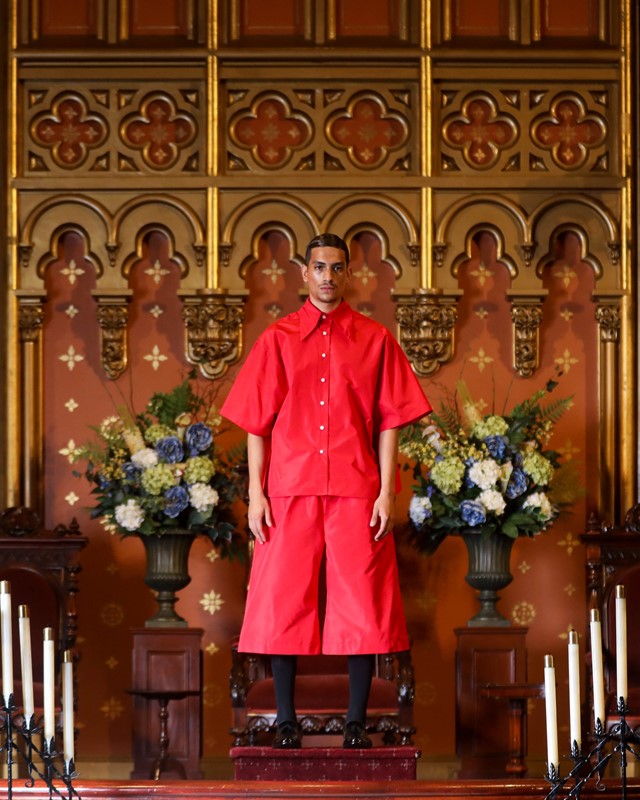
Outsized silhouettes gave plenty of room for the designer to show off these fine fabrics, with shoulders, lapels and legs widened to amplified proportions and beautiful mutton sleeves pooling elegantly at the wrist. A muted palette of navy, black and khaki meant the twisted workwear and sportswear garments, tracksuits, shorts and logoed sweaters blended into the parade of similarly muted but powerful suits. This mash-up was present in the fabrics, too – jackets of red taffeta, black rubberised shirts and baby blue satin shone amid the more sombre shades. Their great volume was aptly reminiscent of the zoot suit: the Zoot Suit Riots took place in Los Angeles in June 1943, during which Latino and Mexican-American youths were attacked by members of the US military and white Angelenos – supposedly because their outfits used an unpatriotic excess of fabric (it was wartime). But racism and fear of gang violence rather than the aesthetics of the Pachucos’ style were at the heart of the issue. “These communities were punished, arrested and jailed because of the way they dressed,” Chavarria says. “Their clothing was a political expression – even though it was beautiful, refined and cool – and it went on to inspire decades of fashion. But at the time people were stripped of their clothes and beaten to the ground in front of their families. It was pretty horrible.” The men and women Chavarria sent out were dignity personified: beautiful and otherworldly in their expansive garments. “I think reclaiming territory has been at the root of gang culture,” the designer says. “And it’s about reclaiming space through what we’re wearing – whether it’s a volume or a silhouette that takes up the space in the room, or a sharp striking silhouette that takes up the conversation in the fashion world.”
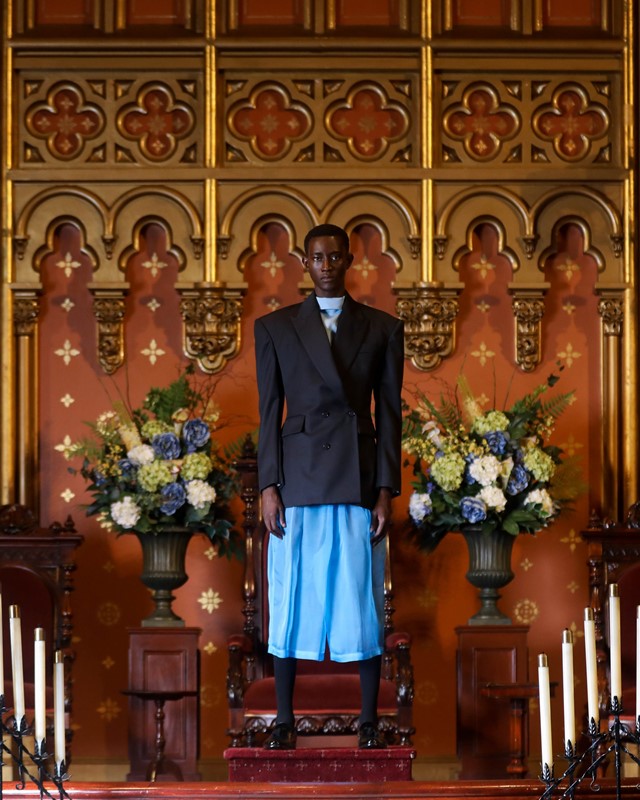
The world Chavarria creates each season grows ever larger. By calling his collection Please Rise, he wasn’t just aiming at the guests in attendance, but at anyone fashion touches. “I think that people who are in high places in the fashion industry, who may have disregarded my vision a few years ago, are now not only embracing my vision but they’re realising they need it,” he says of the change he feels. “Not only do I have the opportunity to share my work, I can help change or influence the fashion industry as it is. And there’s opportunity in such a huge industry that touches so many people to have a positive effect on culture.” Please Rise was Chavarria’s call to arms, his fantasy of what the world could look like. “I was asking people to rise up and appreciate themselves – to rise to the best of their abilities.” He laughs. “Also to stand up and watch the show, because I wasn’t sure how good the visibility from the pews was.”
This story features in the Spring/Summer 2023 issue of AnOther Magazine, which is on sale now. Order here.
